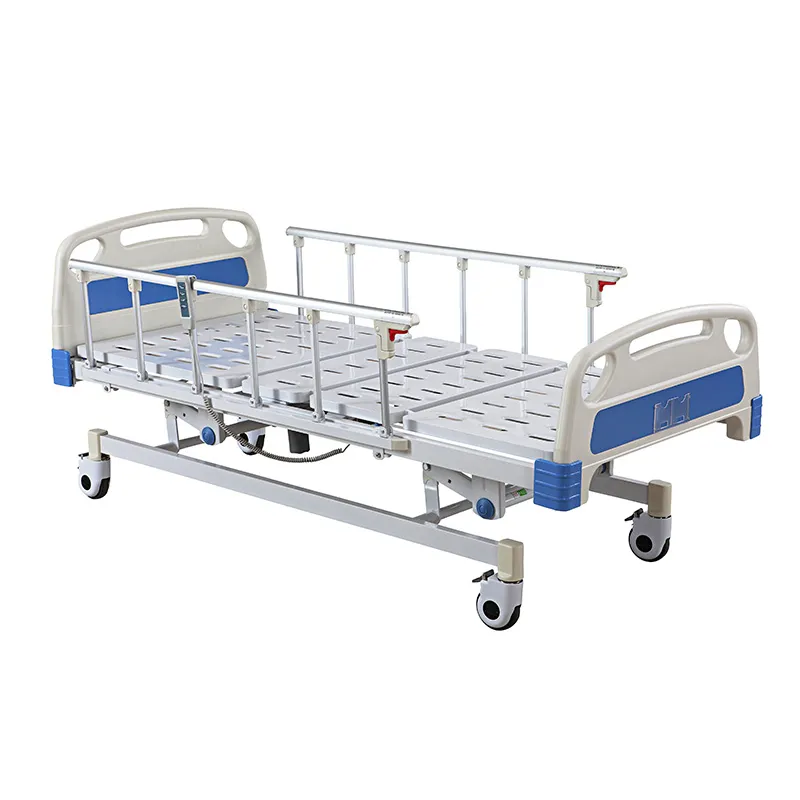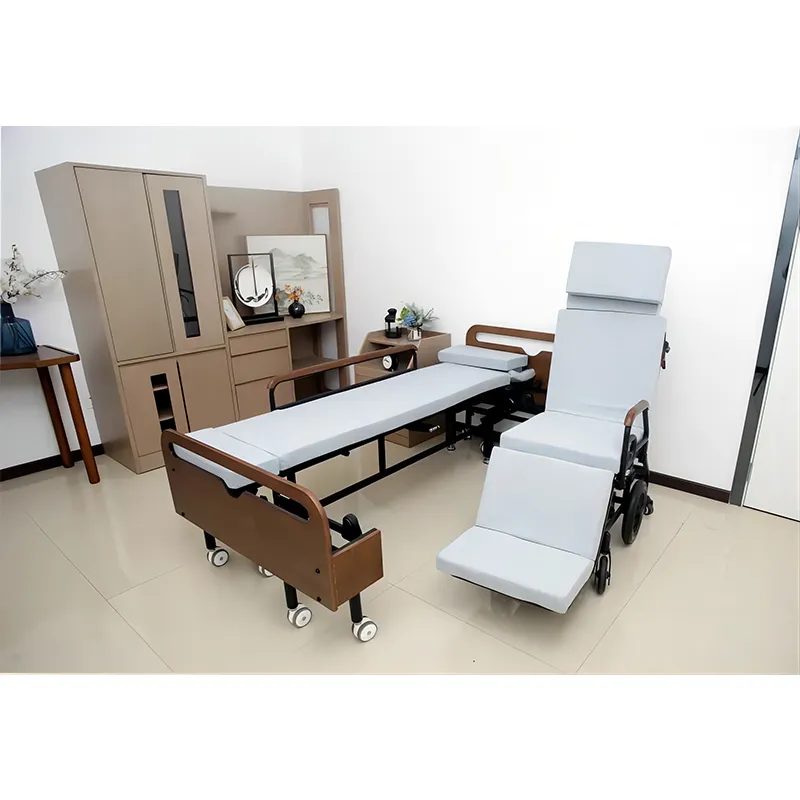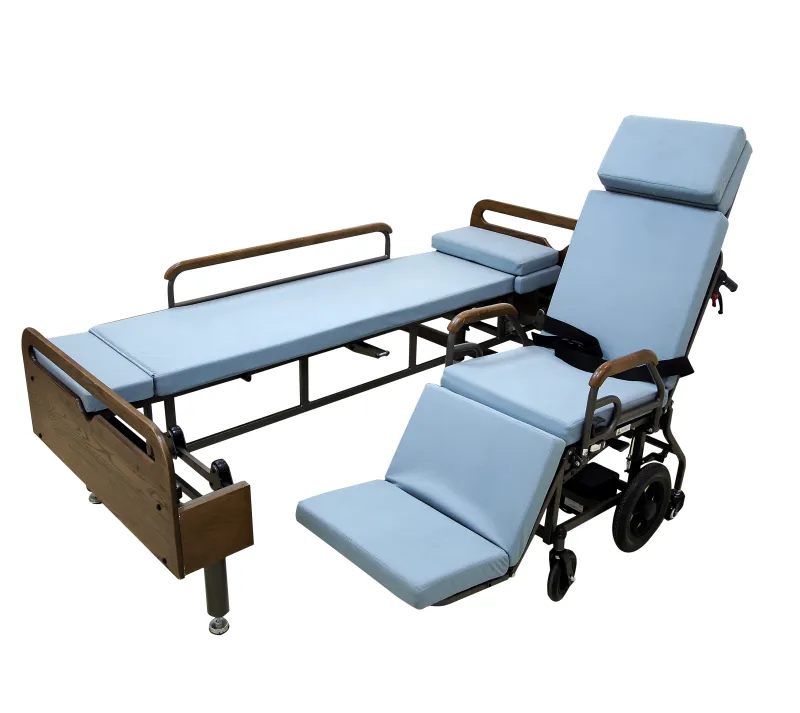
كيف تعمل أسرة المستشفيات الكهربائية؟
2024-10-15 15:30
تختلف سعة وزن أسرة المستشفيات الكهربائية وفقًا للطرازات والتصميمات المختلفة، ولكن معظم أسرة المستشفيات الكهربائية لديها سعة وزن تتراوح بين 350 و600 رطل (حوالي 159 إلى 272 كجم). بالنسبة للمرضى الذين يحتاجون إلى رعاية خاصة، توجد أيضًا بعض الأسرة الكهربائية المقواة في السوق والتي يمكنها تحمل أوزان تصل إلى 800 رطل (حوالي 363 كجم) أو أكثر.عند اختيار سرير كهربائي، يجب مراعاة وزن المريض ووزن المرتبة لضمان إمكانية استخدام السرير بأمان في مختلف المواقف. قد يؤدي التحميل الزائد إلى زيادة تحميل المحرك، وإتلاف هيكل السرير، وحتى التسبب في مخاطر أمنية خطيرة. are an indispensable piece of equipment that are widely used in hospitals, nursing facilities, and even home care settings. These beds not only improve patient comfort, but also reduce the burden on caregivers. Understanding the working principles and functions of electric hospital beds is essential for patients, caregivers, and potential buyers.

How do electric hospital beds work?
Electric beds combine comfort and functionality to make life easier for users and caregivers performing any duties. Electric beds plug into an outlet and users control them via a remote control attached to the side of the bed. The drive system must use a VDE-approved power source – a 220V, 50/60Hz power outlet. This power drives the user's ability to place the bed in different positions, eliminating the physical labor required to operate a semi-electric or manual bed. The adjustable position allows the user to increase the backrest height up to 90 degrees.
The core working principle of an electric hospital bed is a drive system based on an electric motor, which allows the bed to be adjusted to different heights and angles as needed. Electric beds are usually equipped with multiple electric motors, which are connected to the control system by wires. The control system can be a handheld controller or a button on the side of the bed.
These motors are usually used for the following functions:
● Adjust the height of the bed: The overall height of the bed can be adjusted up and down, which is especially important for caregivers because it can reduce the number of times they bend over when handling patients, thereby reducing the physical burden.
● Adjust the angle of the head and foot of the bed: The raising and lowering of the head of the bed can help patients get more comfort when sitting up, while the adjustment of the foot of the bed can improve the patient's blood circulation and prevent problems such as varicose veins.
● Tilt function: Some advanced electric beds also have a tilt function, which allows the bed to tilt to one side as a whole, helping to reduce the pressure injuries caused by long-term bed rest.
Electric beds are very simple to operate. Users only need to operate them through buttons on the controller. The controller is usually clearly marked for easy use by patients or caregivers.
What type of mattress can I use on an electric bed?
The choice of mattress type for electric beds is crucial to the comfort and health of patients. Since electric beds require frequent angle adjustments, ordinary mattresses may not be suitable. Here are some common types of electric hospital bed mattresses:
● Foam mattresses: These mattresses are usually made of high-density foam materials that provide good support and comfort. Foam mattresses are flexible and can change shape as the bed is adjusted, making them a common choice for electric hospital beds.
● Air mattresses: Air mattresses contain multiple air chambers that can be adjusted by pumping or releasing air. It is particularly suitable for patients who are bedridden for a long time because it can help reduce pressure points and prevent bedsores.
● Gel mattresses: These mattresses usually have a gel layer added to the foam mattress, providing better heat dissipation and helping to maintain the patient's body temperature. Gel mattresses are a good choice for patients who sweat easily or have poor temperature regulation.
When choosing a mattress, you must consider the flexibility of the mattress and whether it is compatible with the adjustment function of the electric hospital bed. Mattresses that are too hard or not flexible enough may affect the adjustment effect of the electric hospital bed.

What materials are needed to make an electric hospital bed?
Hospital beds must use the most advanced processing technologies that are also free of harmful substances. Manufacturers must carefully select all the elements required and conduct continuous quality control on them. The materials used to finish the surface of electric beds do not contain chlorofluorocarbons (CFCs) and solvents. The material selection of electric beds is also directly related to their durability, functionality and comfort. The following are several key materials commonly used in the manufacture of electric beds:
● Steel: Steel is usually used to make the frame part of electric beds. Steel has high strength and durability, and can withstand a lot of weight and frequent adjustment movements. In addition, the coating of steel is usually rust-proof, which prolongs the service life of the bed.
● Plastics and composites: Some non-load-bearing parts such as side rails and control panels are usually made of plastic or composite materials. Plastic materials are light and easy to clean, while also avoiding the cold feeling of some metal materials, improving patient comfort.
● Motors and electrical components: Motors, wires and controllers are the core components of electric beds. Motors usually need to have enough power to ensure smooth and quiet operation of the bed, while wires need to have good insulation properties to ensure safe use.
● Mattress materials: As mentioned earlier, mattresses are made of a variety of materials, including foam, air and gel. Each material has its own unique properties and uses, designed to improve patient comfort and health.

What happens to an electric bed during a power outage?
During a power outage, an electric bed loses power and cannot be adjusted by the motor. However, many electric beds are designed with emergency power or manual adjustment features to cope with this situation.
● Backup battery: Some electric beds are equipped with a backup battery that can continue to provide power for a short period of time during a power outage, ensuring that the bed can still be adjusted in an emergency. These batteries usually only last for a few hours, so the power supply should be restored as soon as possible.
● Manual adjustment: Some electric beds are designed with a manual adjustment system that allows users to make simple adjustments mechanically. This function is particularly important when there is no backup battery. Although it may be slightly inconvenient to operate, it can ensure that the patient does not completely lose the adjustment function during the power outage.
● Note: In the event of a long power outage, caregivers should ensure that the bed is in the most comfortable and safe state for the patient, and avoid frequent adjustments to the bed position to preserve emergency power.
How to adjust an electric bed?
The method of adjusting an electric bed varies depending on the specific model and function, but most beds are equipped with simple and easy-to-use controls. Here are the steps for how to adjust an electric hospital bed in general:
● Adjust the height: The height of the bed can be adjusted by the "Lift" button on the controller. For caregivers, adjusting the bed to waist height helps reduce bending and reduces the burden on the waist.
● Adjust the angle of the head and foot of the bed: There are usually special buttons on the controller to adjust the angle of the head and foot of the bed. Adjusting the angle of the head of the bed helps patients get a comfortable posture when sitting up, while adjusting the foot of the bed can relieve leg pressure and promote blood circulation.
● Use special functions: Some advanced electric hospital beds have special functions, such as full bed tilt, massage function, etc. Users can operate them through the corresponding buttons on the controller.
● Lock function: To prevent misoperation, some electric hospital beds are also equipped with a lock function to ensure that the bed will not be accidentally adjusted without the patient's knowledge.

What is the weight capacity of an electric hospital bed?
The weight capacity of electric hospital beds varies depending on different models and designs, but most electric hospital beds have a weight capacity between 350 and 600 pounds (about 159 to 272 kilograms). For patients who need special care, there are also some reinforced electric beds on the market that can bear weights of 800 pounds (about 363 kg) or more.
When choosing an electric bed, you must take into account the weight of the patient and the weight of the mattress to ensure that the bed can be used safely in various situations. Overloading may cause the motor to overload, damage the bed structure, and even cause serious safety hazards.
ما هي قدرة تحمل وزن سرير المستشفى الكهربائي؟







